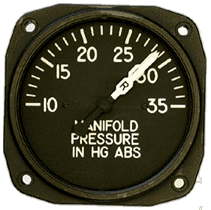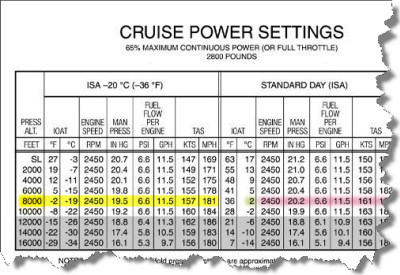What is manifold pressure?
Here is a simple enough question that made it to my inbox today:
What exactly is meant by Manifold Pressure?
The manifold pressure gauge is an engine instrument typically used in piston aircraft engines to measure the pressure inside the induction system of an engine. In other words, it literally reads the pressure inside the induction system.
Correction: A good pilot is always learning right? Well, since writing this post I have learned that the manifold pressure gauge is really NOT about pressure but about suction! Think about it. Your whole engine (especially the cylinders) is a big vacuum pump. Every time the piston drops into the “intake” stroke it is literally pulling or sucking air into the cylinder. Your manifold pressure gauge is actually reading suction not ram air pressure. That’s why at idle power your manifold pressure gauge might read 10 or 12 inches when the outside ambient pressure is 30 inches. Your engine is literally starving for air! It is creating a vacuum or negative pressure inside the intake manifold.
The induction system of couse being the air / fuel mixture that is between the throttle and the cylinders.

This measurement, which is read in inches of mercury or “in hg”, is one of the best methods to determine just how much power is being developed by the engine. The more air and fuel we can pump or pull into the cylinders, the more power the engine can develop (which makes us fly faster). When you can measure how much air pressure is in the induction system, just before the air / fuel mixture enters into the cylinders, you will have a good idea of how much power you are developing.
In normally aspirated engines (non turbo-charged), the manifold pressure gauge has a range of anwhere between 10 – 40 in. hg (or inches of mercury). In a turbocharged engine, the manifold pressure is allowed to go as high as the engine manufacturer allows. When the engine is shut down, the manifold pressure gauge should read very close to the current atmospheric pressure setting.
In order to equate manifold pressure to aircraft performance we need to look in section 5, or the performance section of our Airplane Flight Manual:
 Take a look at this sample above. You can see that at 8,000 feet pressure altitude, -2 C, and 2,450 RPM we would be developing about 19.5 inches of mercury in the induction system. You can also see how that would then be related to fuel flow and our true air speed.
Take a look at this sample above. You can see that at 8,000 feet pressure altitude, -2 C, and 2,450 RPM we would be developing about 19.5 inches of mercury in the induction system. You can also see how that would then be related to fuel flow and our true air speed.


Allan on Oct 09, 2019
My single engine aeroplane has a fixed pitch prop. It also has a manifold pressure gauge (mpg). I see in old fotos that this was always so. The mpg is not connected. I attached a hose and see that the needle moves about 1cm when I suck or blow. A friend who has same type of plane, but with constant speed prop (csp) , tells me that the mpg is only needed if the plane has a csp. Is it worth my time to connect the mpg to the engine? What will be the benefit?
Thanks. Allan
John Durko on Oct 11, 2019
Allan, with a fixed pitched prop, the tachometer alone is sufficient as a proxy for the power being produced by the engine. (density altitude etc not withstanding). That is why you were likely taught various power setting for standard phases of flight.
With a CSP, the tachometer is no longer useful as a proxy for engine power given that the governor will adjust the pitch of the propeller in order to maintain the desired RPM. RPM alone is not enough information to gauge the power setting of the engine or estimate the thrust being delivered by the prop if the pitch can change as it does in a CSP.
So you (or at least an A*P) add a MP gauge, but the data provided is not particularly useful as all the power settings in the POH will be in RPM for a fixed pitch airplace.
Hope this helps..
Barry on Dec 08, 2019
I read the posts on MPG. My QUESTION is:
Should the MPG be ALTITUDE COMPENSATED?
And, if so why?
Thank you,
Barry